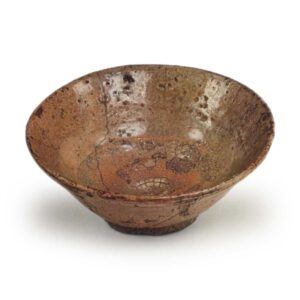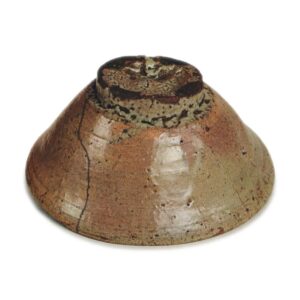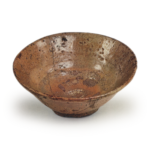

Held in the Hatakeyama Memorial Museum
Height: 5.4-6.4cm
Diameter: 13.3-13.7cm
Foot diameter: 5.0-5.4cm
Height: 1.1cm
It is named after Koshin, the second son of Sen Sōtan, who succeeded to the Fushian tea house (Omote-senke). Koshin died on October 27th, 1672 at the age of 54, and it is said that he served Tokugawa Yorinobu of Kishu and was given 200 koku of rice.
The shape of the tea bowl is well-defined and compact, which is exactly what you would expect from a Koido tea bowl. It is also a tea bowl that is full of the wabi-sabi aesthetic that is said to have been favored by the tea master Kosai.
In his book Tsurezure no Tomo,
Matsuyama Seidō wrote, “The diameter of the bowl is 10 sun (approx. 30 cm), and in some places it is 9 sun and a half (approx. 27 cm). The body is reddish with patches of blue, and it has a history of both old and new. There are many areas where the foot of the bowl is flared, and there is a little bit of tea-staining in the middle of the bowl, which is a little off-center. , the glaze flows down the sides of the bowl, and there is a lot of reddish coloring on the sides, and there is a good amount of white glaze inside, and the overall color is a mixture of blue and red, and the bowl is soft and pliable, and the foot of the bowl stands up well, and there is a lot of inner glaze. …
The beauty of this tea bowl lies in the softness of the glaze, especially the way the blue and red colors alternate, and the way the glaze on the inside of the bowl, which looks like a plum blossom skin, creates a vivid contrast with the wabi-like atmosphere of the piece.
The shape is unique, with a slightly pointed mouth and a distinctive transition from the body to the rim, and the foot is also large and high compared to the overall size of the bowl. The foot of the bowl shows a strong scraping pattern that is unexpected for a small tea bowl, and the quality of the glaze also adds to the overall effect, making this another rare piece from Koido. The thickness is a little thick for a small bowl.
There are four marks on both the foot ring and the inside of the bowl. There are also two cracks on the inside of the bowl, and there are six or seven cracks of various sizes on the rim and the body.
The calligraphy on the inside of the lid, “井戸” (well), is by Koshin, and Koshin’s fifth generation descendant, Kakusai, wrote on the back of the lid that the calligraphy on the lid was by Koshin. After that, it was passed down from the Senke family to Chujyu Yamanaka and Shuho Matsudaira, and according to the “Kushinroku” (a record of the hardships of the tea ceremony) by Ryoun Hontaya, it entered the Hirose family in the Tempo era from Shuho Matsudaira for 1,220 gold koban, and then passed through the hands of Rogen Toda , and then passed through the hands of Murahikohei of Kanazawa and Tokuzo of Osaka before ending up in the collection of Kazukiyo Hatakeyama, who founded the Hatakeyama Memorial Museum.
Both the box and the calligraphy are different from the taste and style of Enshu and the brushwork, and have a simple, wabi-like quality that is characteristic of the Senke school, which is also very pleasing. It is said that it was sold for 1,200 ryou in the Tempo era, which shows that it was highly valued from that time.








